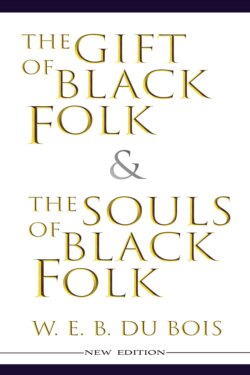Читать книгу The Gift of Black Folk & The Souls of Black Folk (New Edition) - W. E. B. Du Bois - Страница 23
На сайте Литреса книга снята с продажи.
6. The Fugitive Slave
ОглавлениеBeside force and the appeal to reason, there was a third method which practically was more effective and decisive for eventual abolition, and that was the escape from slavery through running away. On the islands this meant escape to the mountains and existence as brigands. In South America it meant escape to the almost impenetrable forest.
As I have said elsewhere:97
“One thing saved the South from the blood sacrifice of Haiti—not, to be sure, from so successful a revolt, for the disproportion of races was less, but from a desperate and bloody effort—and that was the escape of the fugitive.
“Along the Great Black Way stretched swamps and rivers and the forests and crests of the Alleghanies. A widening, hurrying stream of fugitives swept to the havens of refuge, taking the restless, the criminal and the unconquered—the natural leaders of the more timid mass. These men saved slavery and killed it. They saved it by leaving it to a false seductive dream of peace and the eternal subjugation of the laboring class. They destroyed it by presenting themselves before the eyes of the North and the world as living specimens of the real meaning of slavery.
“Three paths were opened to the slaves: to submit, to fight or to run away. Most of them submitted, as do most people everywhere, to force and fate. To fight singly meant death and to fight together meant plot and insurrection—a difficult thing, but one often tried. Easiest of all was to run away, for the land was wide and bare and the slaves were many. At first they ran to the swamps and mountains and starved and died. Then they ran to the Indians and in Florida founded a nation, to overthrow which cost the United States $20,000,000 and more in slave raids known as the Seminole ‘wars.’ Then gradually, after the War of 1812 had used so many black sailors to fight for free trade that the Negroes learned of the North and Canada as cities of refuge, they fled northward.”
From the sixteenth century, Florida Indians had Negro blood, but from [the] early part of the nineteenth century the Seminoles gained a large new infiltration of Negro blood from the numbers of slaves who fled to them and with whom they intermarried. The first Seminole war, therefore, in 1818 was not simply a defense of the frontiers against the Indians and a successful raid to drive Spain from Florida, it was also a slave raid by Georgia owners determined to have back their property. By 1815, Negroes from Georgia among the Creeks and Seminoles numbered not less than 11,000 and were settled along the Appalachicola river, many of them with good farms and with a so-called Negro “fort” for protection. The war was disastrous to Negroes and Indians, but not fatal, and in 1822 some 800 Negroes were counted among the Indians who inhabited the new territory seized from Spain. Pressure to secure alleged fugitives and Negroes from the Indians was kept up for the next three years and the second Seminole war broke out because the whites treacherously seized the mulatto wife of the Indian chief Osceola. The war broke out in 1837 and its real nature, as a New Orleans paper said in 1839, was to subdue the Seminoles and decrease the danger of uprisings “among the serviles.” Finally after a total cost of twenty million dollars, the Indians were subdued and moved to the West and a part of the Negroes driven back into slavery, but not all.98
Through the organization, which came to be known as the Underground Railroad, thousands of slaves escaped through Kentucky and into the Middle West and thence into Canada and also by way of the Appalachian Mountains into Pennsylvania and the East. Not only were they helped by white abolitionists, but they were guided by black men and women like Joshua Henson and Harriet Tubman.
Beside this there came the effort for emigration to Africa which was very early suggested. Two colored men sailed from New York for Africa in 1774, but the Revolutionary War stopped the effort thus begun. The Virginia legislature, in secret session after Gabriel’s insurrection in 1800, tried to suggest the buying of some land for the colonization of free Negroes, following the proposal of Thomas Jefferson made in 1781. Paul Cuffee, mentioned [earlier], started the actual migration in 1815 carrying nine colored families, thirty-eight persons in all, to Sierra Leone at an expense of $4,000 which he paid himself. Finally came the American Colonization Society in 1817 but it was immediately turned from a real effort to abolish slavery gradually into an effort to get rid of free Negroes and obstreperous slaves. Even the South saw it and Robert Y. Hayne said in Congress: “While this process is going on, the colored classes are gradually diffusing themselves throughout the country and are making steady advances in intelligence and refinement and if half the zeal were displayed in bettering their condition that is now wasted in the vain and fruitless effort of sending them abroad, their intellectual and moral improvement would be steady and rapid.”
